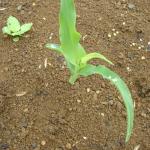Growing Sweet corn, also corn,maize
Zea mays, var. rugosa : Poaceae / the grass family
| Jan | Feb | Mar | Apr | May | Jun | Jul | Aug | Sep | Oct | Nov | Dec |
|---|---|---|---|---|---|---|---|---|---|---|---|
| P | P |
(Best months for growing Sweet corn in USA - Zone 5a regions)
- P = Sow seed
- Sow in garden. Sow seed at a depth approximately three times the diameter of the seed. Best planted at soil temperatures between 61°F and 95°F.
- Space plants: 8 - 12 inches apart
- Harvest in 11-14 weeks.
- Compatible with (can grow beside): All beans, cucumber, melons, peas, pumpkin, squash, amaranth
- Avoid growing close to: Celery.
Plant in 4 by 4 blocks to encourage germination Pick when the silky threads on the cobs turn brown or black. Part the top of the leaves and test for ripeness by pressing a grain with your fingernail. If it is milky, it is ready.
Early varieties ripen quickly and are sweeter when just picked.
Avoid planting coloured maize ( for drying) near sweetcorn as they will cross-pollinate and spoil the cobs on both.
Culinary hints - cooking and eating Sweet corn
Pick and cook within an hour. Remove the silks and outer leaves.
Best flavour if microwave about 4 minutes per cob.
Can be barbequed wrapped in foil
Cook large amounts in a stock pot until test soft.
Sprinkle with black pepper and dip in butter.




Your comments and tips